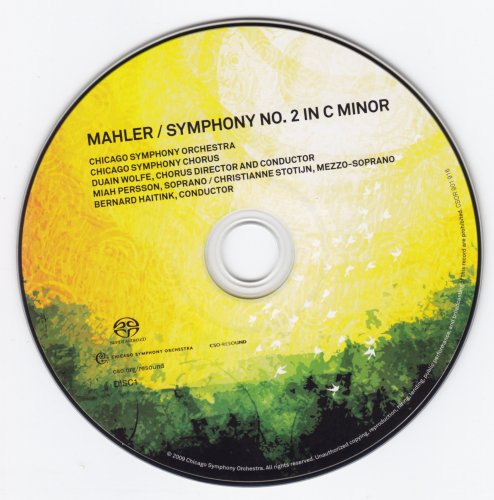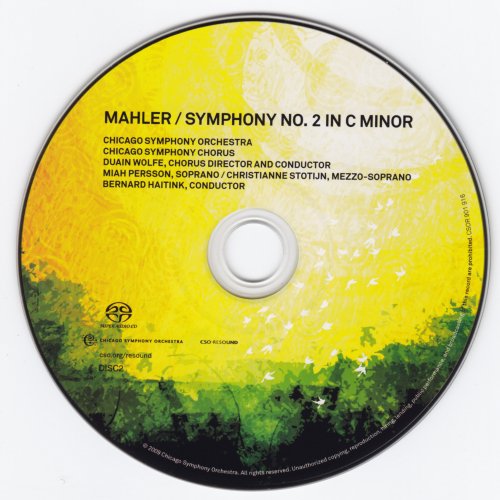
Bernard Haitink, Chicago Symphony Orchestra - Mahler: Symphony 2 (2009) [SACD]
BAND/ARTIST: Bernard Haitink, Chicago Symphony Orchestra
- Title: Mahler: Symphony 2
- Year Of Release: 2009
- Label: CSO Resound
- Genre: Classical
- Quality: DSD64 image (*.iso) / 2.0, 5.1 (2,8 MHz/1 Bit)
- Total Time: 01:22:02
- Total Size: 4.91 GB
- WebSite: Album Preview
Tracklist:
Disc: 1
1. Allegro maestoso. Mit durchaus ernstem und feierlichem Ausdruck 21:12
Disc: 2
1. Adante moderato. Sehr gemachlich. Nie eilen 10:09
2. Scherzo. In ruhig filessender Bewegung 11:09
3. Urlicht (Primal light). Sehr feierlich, aber schlicht 4:59
4. Im tempo des Scherzos. Wild herausfahrend 34:33
![Bernard Haitink, Chicago Symphony Orchestra - Mahler: Symphony 2 (2009) [SACD]](https://www.dibpic.com/uploads/posts/2021-02/1613389976_back.jpg)


Disc: 1
1. Allegro maestoso. Mit durchaus ernstem und feierlichem Ausdruck 21:12
Disc: 2
1. Adante moderato. Sehr gemachlich. Nie eilen 10:09
2. Scherzo. In ruhig filessender Bewegung 11:09
3. Urlicht (Primal light). Sehr feierlich, aber schlicht 4:59
4. Im tempo des Scherzos. Wild herausfahrend 34:33
As a seasoned conductor of the symphonies of Gustav Mahler, Bernard Haitink can be expected to turn in an insightful and moving performance of the Symphony No. 2 in C minor, “Resurrection.” For that matter, the Chicago Symphony Orchestra has played this work numerous times under various conductors, and it is as experienced in this repertoire as any orchestra in the world; one should be able to predict that its playing would be splendid. Furthermore, CSO Resound can be trusted to produce a sterling hybrid SACD twofer that brings the music across with full-frequency reproduction and with astonishing depth and marvelous tone colors. It should come as no surprise, then, that this 2009 audiophile recording is one of the finest available of this popular work, albeit with some minor problems of pacing and interpretation. For better or worse, the “Resurrection” has become a concert warhorse, which means it is widely played and well-known to audiences everywhere, but it has also become overly familiar, a bit comfortable, and too easy to take, far from the emotionally shattering experience Mahlerintended. It is true that there have been recordings with fiercer openings, and that the first movement takes a while to build momentum here; but it would be a mistake to expect all the expressive force to come in the work’s early stages, especially after the first movement’s collapse and the peaceful interlude of the second. The energy is certainly elevated in the scherzo, where the symphony resumes its surge to the Finale. Yet Haitink‘s sense of pacing holds the scherzo in check, and it really doesn’t become explosive until it reappears, after the calming Urlicht. When the Finale comes, all the pent-up force is released at last, and Haitink‘s feeling for monumental, apocalyptic scene-painting is wonderful. So this performance is eloquent and ultimately moving in the Klopstock Ode, and anyone looking for world-class playing will be quite happy with it. But anyone looking for a devastating, soul-searing rendition will feel that this one is a little too conservative and careful in its build-up to really do the job.
Review from Classicstoday.com:
The Chicago Symphony Orchestra probably can play this symphony by heart, and certainly its fabled brass (particularly trombones and horns), as well as the superb chorus, give the big moments the weight that they require. The problem is that the rest of the orchestra–not to mention Bernard Haitink–seems not to be making a similar effort. As an interpreter, Haitink remains a cypher. This is at least his fourth authorized recording of this symphony, and while it’s not quite as dull as his Berlin remake for Philips, it contains neither a single distinctive interpretive idea nor an atom of passion.
While up to tempo, there’s no sense of struggle in the first movement, no menace in its coda, no quirky humor in the scherzo, and the finale lacks any sense of urgency–it particularly hangs fire as soon as the chorus enters. The “cry of despair” in the third movement is impressive because the orchestra knows how it goes, not because Haitink takes any trouble to make something special of it. Similarly the final chorale has impact because the chorus sings wonderfully, and the organ pedals are well caught by the otherwise low-level recording.
But where is the bite to the cellos and basses at the symphony’s opening, the vigor in the finale’s “dead march”, or the transcendent power of the final pages (almost no bells, by the way)? It’s Haitink on autopilot, as he so often seems to be these days. Among the soloists Christianne Stotijn turns in a lovely “Urlicht”, but Miah Persson’s voice lacks the necessary purity to float over the choir in her first two entrances in the finale.
This is nothing more than a respectable, workaday subscription performance that any paying concertgoer surely would have enjoyed, but it has no business being preserved and issued on disc. Haitink’s finest “Resurrection” by far remains his first, more as a classic example of a great Mahler orchestra’s characteristic style in the 1960s than for anything he brings to the party. His later performances prove convincingly that most of the credit for the excellence of that first version does not rest with the conductor. There is something to be said for his naturally self-effacing approach, his willingness to let the music “speak for itself”–but then, why keep recording it over and over? Enough already.
Review from Classicstoday.com:
The Chicago Symphony Orchestra probably can play this symphony by heart, and certainly its fabled brass (particularly trombones and horns), as well as the superb chorus, give the big moments the weight that they require. The problem is that the rest of the orchestra–not to mention Bernard Haitink–seems not to be making a similar effort. As an interpreter, Haitink remains a cypher. This is at least his fourth authorized recording of this symphony, and while it’s not quite as dull as his Berlin remake for Philips, it contains neither a single distinctive interpretive idea nor an atom of passion.
While up to tempo, there’s no sense of struggle in the first movement, no menace in its coda, no quirky humor in the scherzo, and the finale lacks any sense of urgency–it particularly hangs fire as soon as the chorus enters. The “cry of despair” in the third movement is impressive because the orchestra knows how it goes, not because Haitink takes any trouble to make something special of it. Similarly the final chorale has impact because the chorus sings wonderfully, and the organ pedals are well caught by the otherwise low-level recording.
But where is the bite to the cellos and basses at the symphony’s opening, the vigor in the finale’s “dead march”, or the transcendent power of the final pages (almost no bells, by the way)? It’s Haitink on autopilot, as he so often seems to be these days. Among the soloists Christianne Stotijn turns in a lovely “Urlicht”, but Miah Persson’s voice lacks the necessary purity to float over the choir in her first two entrances in the finale.
This is nothing more than a respectable, workaday subscription performance that any paying concertgoer surely would have enjoyed, but it has no business being preserved and issued on disc. Haitink’s finest “Resurrection” by far remains his first, more as a classic example of a great Mahler orchestra’s characteristic style in the 1960s than for anything he brings to the party. His later performances prove convincingly that most of the credit for the excellence of that first version does not rest with the conductor. There is something to be said for his naturally self-effacing approach, his willingness to let the music “speak for itself”–but then, why keep recording it over and over? Enough already.
![Bernard Haitink, Chicago Symphony Orchestra - Mahler: Symphony 2 (2009) [SACD]](https://www.dibpic.com/uploads/posts/2021-02/1613389976_back.jpg)


As a ISRA.CLOUD's PREMIUM member you will have the following benefits:
- Unlimited high speed downloads
- Download directly without waiting time
- Unlimited parallel downloads
- Support for download accelerators
- No advertising
- Resume broken downloads


![Bernard Haitink, Chicago Symphony Orchestra - Mahler: Symphony 2 (2009) [SACD]](https://www.dibpic.com/uploads/posts/2021-02/1613389947_front.jpg)